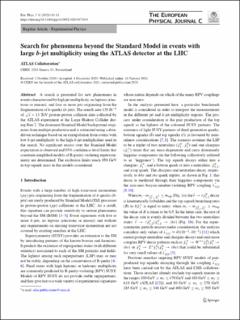Search for phenomena beyond the Standard Model in events with large b-jet multiplicity using the ATLAS detector at the LHC
Aad, Georges; Abbott, Brad; Abed Abud, Adam; Abeling, Kira; Abhayasinghe, Deshan Kavishka; Abidi, Syed Haider; AbouZeid, Ossama Sherif Alexander; Abraham, Nadine L.; Abramowicz, Halina; Abreu, Henso; Bjørke, Kristian; Bugge, Magnar Kopangen; Cameron, David Gordon; Catmore, James Richard; Garonne, Vincent; Gramstad, Eirik; Heggelund, Andreas Løkken; Hellesund, Simen; Håland, Even Simonsen; Morisbak, Vanja; Oppen, Henrik; Ould-Saada, Farid; Pedersen, Maiken; Read, Alexander Lincoln; Rye, Eli Bæverfjord; Røhne, Ole Myren; Sandaker, Heidi; Vadla, Knut Oddvar Høie; Buanes, Trygve; Djuvsland, Julia Isabell; Eigen, Gerald; Fomin, Nikolai; Latour, Pascal Christian Martin; Lee, Graham Richard; Lipniacka, Anna; Stugu, Bjarne Sandvik; Træet, Are Sivertsen; Abulaiti, Yiming; Acharya, Bobby S.; Achkar, Baida; Adam, Lennart; Adam-Bourdarios, Claire; Adamczyk, Leszek; Adamek, Lukas; Adelman, Jareed; Adersberger, Michael; Adigüzel, Aytül; Adorni, Sofia; Adye, Tim; Affolder, Anthony Allen; ATLAS, Collaboration
Journal article, Peer reviewed
Published version

Åpne
Permanent lenke
https://hdl.handle.net/11250/2977115Utgivelsesdato
2021Metadata
Vis full innførselSamlinger
Sammendrag
A search is presented for new phenomena in events characterised by high jet multiplicity, no leptons (electrons or muons), and four or more jets originating from the fragmentation of b-quarks (b-jets). The search uses 139 fb−1 of √s = 13 TeV proton–proton collision data collected by the ATLAS experiment at the Large Hadron Collider during Run 2. The dominant Standard Model background originates from multijet production and is estimated using a data-driven technique based on an extrapolation from events with low b-jet multiplicity to the high b-jet multiplicities used in the search. No significant excess over the Standard Model expectation is observed and 95% confidence-level limits that constrain simplified models of R-parity-violating supersymmetry are determined. The exclusion limits reach 950 GeV in top-squark mass in the models considered.
